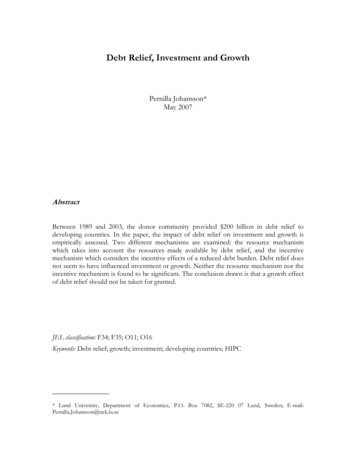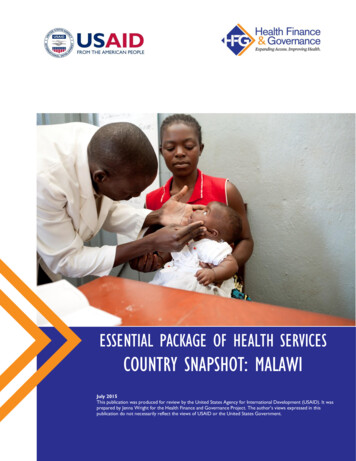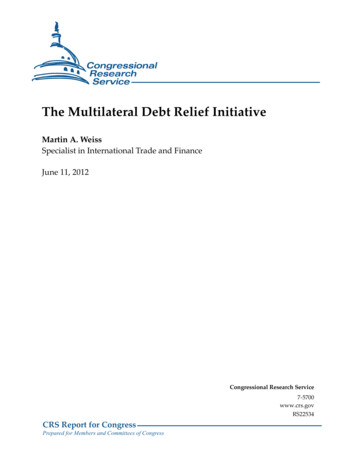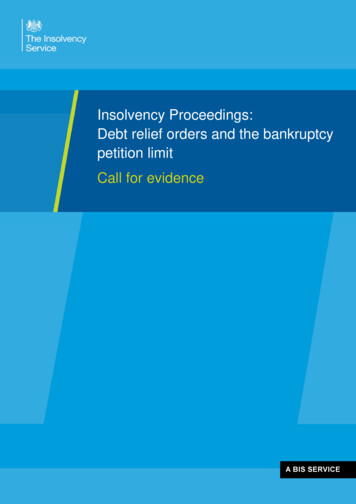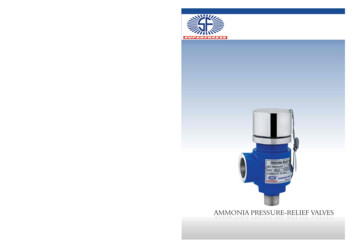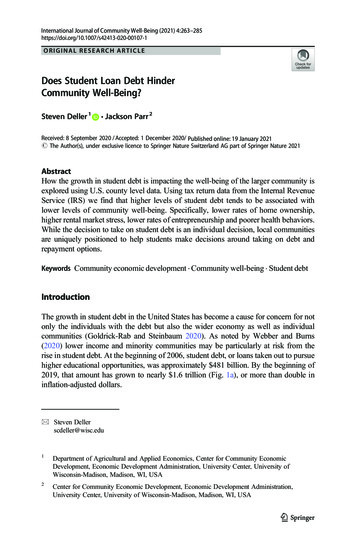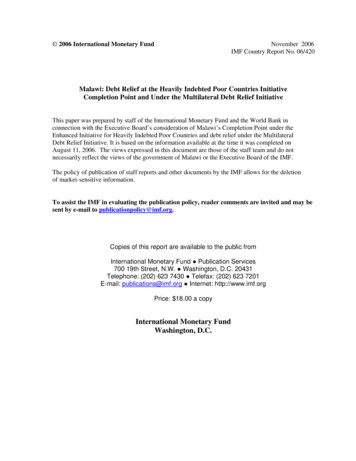
Transcription
2006 International Monetary FundNovember 2006IMF Country Report No. 06/420Malawi: Debt Relief at the Heavily Indebted Poor Countries InitiativeCompletion Point and Under the Multilateral Debt Relief InitiativeThis paper was prepared by staff of the International Monetary Fund and the World Bank inconnection with the Executive Board’s consideration of Malawi’s Completion Point under theEnhanced Initiative for Heavily Indebted Poor Countries and debt relief under the MultilateralDebt Relief Initiative. It is based on the information available at the time it was completed onAugust 11, 2006. The views expressed in this document are those of the staff team and do notnecessarily reflect the views of the government of Malawi or the Executive Board of the IMF.The policy of publication of staff reports and other documents by the IMF allows for the deletionof market-sensitive information.To assist the IMF in evaluating the publication policy, reader comments are invited and may besent by e-mail to publicationpolicy@imf.org.Copies of this report are available to the public fromInternational Monetary Fund Publication Services700 19th Street, N.W. Washington, D.C. 20431Telephone: (202) 623 7430 Telefax: (202) 623 7201E-mail: publications@imf.org Internet: http://www.imf.orgPrice: 18.00 a copyInternational Monetary FundWashington, D.C.
INTERNATIONAL DEVELOPMENT ASSOCIATIONAND INTERNATIONAL MONETARY FUNDREPUBLIC OF MALAWIDebt Relief at the Heavily Indebted Poor Countries (HIPC) Initiative Completion Pointand Under the Multilateral Debt Relief Initiative (MDRI)Prepared by the Staffs of the World Bankand the International Monetary FundApproved by Gobind Nankani and Danny Leipziger (IDA)and Robert J. Corker and Matthew Fisher (IMF)August 16, 2006ContentsExecutive Summary .iI.Introduction.1II.Assessment of Compliance with Requirements for Reaching Completion Point.2A.Implementation of Poverty Reduction Strategy.2B.Macroeconomic Performance During 2001-05 .8C.Implementation of Structural Triggers.11D.Use of HIPC Initiative Interim Assistance.20III.Debt Relief and Debt Sustainability Update.21A.Updated Data Reconciliation for the Decision Point.21B.Status of Creditor Participation and Revision of HIPC Assistance .22C.Debt Sustainability After HIPC Assistance .24D.Considerations for Topping-Up of HIPC Assistance.25E.Debt Relief Under Multilateral Debt Relief Initiative .29F.Debt Sustainability Outlook after MDRI, 2006-25.31G.Sensitivity Analysis .34IV.Conclusions.38V.Issues for Discussion.40
Boxes1.Summary Assessment of Malawi’s Progress in Implementing theCompletion Point Triggers.32.Enhancing Growth in the Malawi Growth and Development Strategy .63.Performance under IMF Programs, 2001-05 .104.Improving Malawi’s Public Expenditure Management.125.Malawi’s Fight Against Corruption .136.Macroeconomic Assumptions Underlying the Debt Sustainability Analysisover 2006-25 .32Tables1.Evolution of NPV of Debt-to-Exports Ratio .272.Resources Used on Protected Pro-Poor Expenditures, FY2001/02FY2004/06 .423.Selected Economic Indicators, 2003-25 .434.Balance of Payments, 2000-09 .445.Comparison of Discount Rate and Exchange Rate Assumptions at end-1999and end-2005.456.Nominal and Net Present Value of External Debt at Decision Point as ofend-December 1999 .467.Estimated HIPC Assistance at Decision Point (Amended).478.Nominal and Net Present Value of External Debt at Completion Point,end-2005 .489.Net Present Value of External Debt, 2005-25 .4910.External Debt Service After Full Implementation of Debt Relief Mechanisms,2006-25 .5011.External Debt Indicators, 2005-25.5112.Enhanced HIPC Initiative Assistance Levels and Possible Topping-Up atCompletion Point .5213.Sensitivity Analysis, 2005-25 .5314.Delivery of IDA Assistance Under the Enhanced HIPC Initiative and MDRI.5415a. Delivery of IMF Assistance under HIPC and MDRI (without possibletopping-up).5515b. Delivery of IMF Assistance Under HIPC and the MDRI(with possible topping-up) .5616.Status of Creditor Participation Under the Enhanced HIPC Initiative .5717.Paris Club Creditors Delivery of Debt Relief on the Bilateral Initiatives .5818.HIPC Initiative: Status of Country Cases Considered Under the Initiative,July 28, 2006.59Figures1.Implied Savings Under the MDRI .302.External Debt and Debt Service Indicators for Medium- and Long-TermPublic Sector Debt, 2005-25 .353.Sensitivity Analysis, 2005-24 .36
AppendicesI.Joint World Bank/IMF Debt Sustainability Analysis Based onLow-Income Country Framework .60II.External Debt Management .68
iEXECUTIVE SUMMARY The staffs of the International Development Association (IDA) and the InternationalMonetary Fund (IMF) are of the view that Malawi has met the requirements forreaching the completion point under the enhanced Heavily Indebted Poor Countries(HIPC) Initiative. Malawi has made satisfactory progress in implementing its PovertyReduction Strategy Paper (PRSP) for at least one year, and maintained satisfactorymacroeconomic policies as evidenced by its performance under a program supported bythe Poverty Reduction and Growth Facility (PRGF) over the last fiscal year 2005/06(July-June). Malawi has also met all the completion point targets in the area of economicgovernance and public expenditure management, safety nets, and microfinance. In thesocial sectors, it has met all but two of the completion point targets. As a result ofimplementing the completion point requirements, Malawi is now poised to accelerate itspace of growth and poverty reduction. The new strategy that is being prepared to succeedthe Malawi Poverty Reduction Strategy (MPRS), will be implemented within the contextof a stable macroeconomic environment, significantly improved public expendituremanagement system, and a conducive framework for improving health and educationoutcomes, as well as for protecting the most vulnerable in society. The two triggers that were not met required government to ensure that the share ofhealth expenditure reached at least 13 percent of discretionary recurrent budgetand that at least 6,000 students enrolled annually for teacher training. Althoughthese targets were not met during the interim period, the authorities made some effortstowards achieving them. With regard to the health expenditure share, the averagebetween 2001/02 and 2004/05 was 12 percent. Following approval of a prioritizedprogram of policies for the health sector that is supported through a Sector WideApproach in 2004, preliminary actual figures show that the health sector’s share ofdiscretionary recurrent spending for 2005/06 increased to 18 percent. With regard toannual enrolment of 6,000 students for teacher training, an attempt was made to increaseenrolment through a crash course but this resulted in a deterioration of quality of trainedteachers. A new program has now been introduced which should help increase thenumber of properly trained teachers deployed in schools. Further, with support fromdonors, the government is implementing construction projects that will increase theenrollment capacity in Teacher Training Colleges (TTCs). However, even with theseefforts, the target of 6,000 is unlikely to be met in the near future and staffs now believethat this target was overly ambitious. The progress made to-date in implementing a broader strategy for raising the quality ofeducation and improving health outcomes justifies the government’s request for
iiwaivers for the non-observance of the two completion point conditions relating to theshare of health sector expenditure and teacher training. At the decision point in December 2000, the Executive Directors agreed that Malawihad met all the criteria to become eligible for debt relief under the enhanced HIPCInitiative. The analysis undertaken at the decision point indicated that HIPC assistance inthe amount of US 643 million in 1999 NPV terms was required to lower Malawi’s NPVof debt-to-exports ratio to the HIPC threshold of 150 percent. IDA and IMF commitmentsto this debt relief were US 331 million and US 30 million, respectively, in NPV terms ofwhich US 99.9 million and US 14.2 million, respectively were delivered as interimassistance as of August 2006. Information from creditors and a downward revision inexports lead to an upward revision of HIPC assistance at the completion point to US 646million in 1999 NPV terms. The completion point analysis of Malawi’s external debt shows a substantialworsening in debt burden indicators compared to the projections made at thedecision point. At decision point, the NPV of debt-to-exports ratio at end-2005 wasprojected to amount to 169 percent assuming full delivery of the assistance committedunder the HIPC Initiative at decision point. The completion point analysis shows theactual outturn to be 245 percent of exports. After additional voluntary bilateral debtrelief, this ratio declines to 229 percent of exports. The substantial deterioration in Malawi’s NPV of debt-to-exports ratio since thedecision point is primarily attributable to exogenous factors, which have led to afundamental change in the country’s economic circumstances. These exogenousfactors include:o lower-than-projected export receipts, which explains a third of the higher NPV ofdebt-to-exports ratio; the price of Malawi’s main export commodity, tobacco, fell by13.6 percent due to declining demand in international markets;o a lower discount rate, which explains about half of the unanticipated increase inMalawi’s NPV of debt-to-exports ratio; while international interest rates havedeclined since the decision point, the nominal debt service burden facing Malawi hasremained broadly unchanged as interest rates on external debt are mostly fixed;o a depreciation of the US dollar against the Euro and SDR, although this was arelatively minor factor;o unanticipated new borrowing, which only lead to a small increase in Malawi’s NPVof debt to exports ratio of 3.8 percent.Finally, unanticipated increases in international oil prices since the decision point havealso contributed to the deterioration in Malawi’s debt servicing capacity.
iii In circumstances where exogenous factors lead to a significant deterioration in debtratios after the decision point, the enhanced HIPC framework allows for additionaldebt relief (topping-up) at the completion point beyond the relief already committedat the decision point. The staffs consider that Malawi’s case meets the requirements fortopping-up at the completion point. Staffs therefore recommend that additional assistanceunder the enhanced HIPC Initiative of US 411 million be granted to bring Malawi’sNPV of debt-to-export ratio from 229 percent at end-2005, to the 150 percent HIPCthreshold, after the application of bilateral debt relief beyond HIPC assistance. Reaching the completion point under the enhanced HIPC Initiative, Malawi willalso qualify for additional debt cancellation under the Multilateral Debt ReliefInitiative (MDRI). As debt relief under the MDRI would cover all remaining debtservice obligations on eligible credit balances to IDA, the IMF and the AfricanDevelopment Fund (AfDF) after any debt service relief available under the HIPCInitiative, the amount of relief under MDRI depends on the Executive Directors’ approvalof topping-up. MDRI debt relief (net of HIPC assistance) would lead to debt servicesavings on debt owed to IDA, the IMF and the AfDF of US 1.9 billion without toppingup and of US 1.4 billion, if topping-up were to be approved. After HIPC debt relief, topping-up of HIPC assistance, and MDRI debt relief,Malawi’s external debt burden indicators fall to levels significantly lower than theaverage of low-income countries. In the long-term, the NPV of debt-to-exports ratio isexpected to increase gradually, but will remain below the HIPC threshold of 150 percent.This projection is based on the assumptions that government maintains prudent fiscalpolicies, implements measures to insulate the economy from the debilitating impact ofperiodic droughts and keeps new borrowing to modest levels and on concessional terms. The staffs of IDA and the IMF recommend that the Executive Directors of IDA andthe IMF approve that Malawi has reached the completion point under the enhancedHIPC Initiative and that Malawi be considered for topping-up under the enhancedHIPC Initiative.
I. INTRODUCTION1.This paper presents an assessment of Malawi’s progress in meeting thecompletion point triggers determined at the decision point under the enhanced HeavilyIndebted Poor Countries (HIPC) Initiative. It seeks approval from the Executive Boardsof the International Development Association (IDA) and the International Monetary Fund(IMF) of Malawi’s completion point under the Initiative, including waivers for two of thecompletion point triggers, revision and topping-up of HIPC assistance.2.Malawi reached the enhanced HIPC Initiative decision point in December 2000.1At the decision point, HIPC assistance required to lower Malawi’s net present value (NPV)of debt-to-exports ratio to the HIPC threshold of 150 percent was estimated at US 643million in NPV terms based on end-1999 debt data. Employing the principle of equal burdensharing, all creditors were expected to reduce the NPV of their claims on Malawi by acommon reduction factor of 43.7 percent, after full use of traditional debt-relief mechanisms.For the IDA and the IMF, the resulting commitments amounted to US 331 and US 30million in NPV terms, respectively. During the interim period between the decision pointand completion points, the IMF provided debt relief of US 14 million in NPV terms, whileIDA provided relief of US 100 million. Malawi has also benefited from interim assistancegranted by the African Development Bank, a number of other smaller multilateral creditorsand Paris Club creditors. Total interim assistance to Malawi was about 151 million in NPVterms.23.The paper is organized as follows: Section II assesses Malawi’s performance inmeeting the requirements for reaching the completion point under the enhanced HIPCinitiative, as set out in the decision point document. Section III reviews the status of creditorparticipation and the delivery of debt relief to Malawi under the enhanced HIPC Initiativeand presents the results of the debt sustainability analysis (DSA) based on end-2005 debt dataand parameters. This section also assesses the sensitivity of debt indicators to changes in keyeconomic variables. Section IV discusses the case for a topping-up of HIPC assistance.Sections V and VI present the conclusions and issues for discussion by the Boards,respectively.1See IDA and IMF, "Malawi. Decision Point Document for the Enhanced Heavily Indebted Poor CountriesInitiative’, December T/DecisionPointDocuments/20250615/Malawi-E-DP.pdf lawidp.pdf2Paris Club creditors have provided additional interim relief beyond HIPC Initiative assistance.
2II. ASSESSMENT OF COMPLIANCE WITH REQUIREMENTS FOR REACHINGCOMPLETION POINT4.The decision point document sets out the conditions for reaching the completionpoint. These include: (i) preparation of a full Poverty Reduction Strategy Paper (PRSP) andits satisfactory implementation for one year; (ii) maintenance of macroeconomic stability andsatisfactory implementation of a PRGF-supported program; and (iii) implementation of keystructural and governance triggers aimed at strengthening public expenditure management,raising the quality of education, improving health outcomes, fighting HIV/AIDS,strengthening land and credit markets, and creating an effective safety net system. Thissection assesses the progress in the implementation of these completion point requirements.In addition, it also presents how Malawi has used the budgetary savings from interim relief.5.In the view of the staffs of IDA and the IMF, Malawi has made satisfactoryprogress in meeting the conditions for the completion point. All but two of thecompletion point triggers have been implemented (Box 1). The first of these two triggersrequired the share of health expenditure to be at least 13 percent of the discretionaryrecurrent budget. The second trigger required ensuring a yearly enrolment of 6,000 studentsfor teacher training. Based on progress in implementing a broader strategy for raising thequality of education and improving health outcomes, as discussed below, it is recommendedthat Executive Directors accept the government’s request for granting waivers for thenon-observance of these two completion point triggers.A. Implementation of Poverty Reduction Strategy6.The preparation of Malawi’s first PRSP in 2001 reflected a highly participatoryprocess that helped in identifying the key development challenges that faced the countryand its implementation provided a good basis on which to improve poverty outcomes.The government is now in the process of finalizing its second-generation strategy - theMalawi Growth and Development Strategy (MGDS) which places much greater emphasis ongrowth as a basis for poverty reduction (Box 2).
3Box 1: Summary Assessment of Malawi’s Progress in Implementing the Completion Point Triggers 3Theme and specific triggersImplementation of Poverty Reduction StrategiesThe full PRSP has been prepared and satisfactorilyimplemented for one year, as evidenced by the jointstaff assessment of the country’s progress report.AssessmentImplemented. A full PRSP, the Malawi Poverty ReductionStrategy Paper (MPRSP), was prepared by the government andwas adopted in April 2002. The first Annual Progress Report inOctober 2003 indicated that MPRSP implementation was limited.The second APR and JSAN (looking at the period July 2003-June2004) indicated that MPRSP implementation was still limited.The third APR (looking at the period July 2004-June 2005) andcorresponding JSAN (submitted together with this document)show that implementation covering the period 2004-05 wasbroadly satisfactory.Macroeconomic PerformanceMaintenance of macroeconomic stability andsatisfactory implementation of the PRGF-supportedprogram.Implemented. Macroeconomic stability has been maintainedsince mid-2004, initially under an IMF SMP and then under aPRGF-supported program. A new three year PRGF was approvedon August 5, 2005. The first review, completed in February 2006,concluded that performance through to end-September 2005 wassatisfactory. The second review, covering performance throughend-December 2005, will be discussed by the IMF ExecutiveBoard concurrently with this document.Improving Economic GovernanceSeparation of fiscal management and audit functionsunder new legislation.Implemented. Legislation was passed in 2003 to separate thefinancial management and audit functions of government.Quarterly expenditure reporting as per format jointlydeveloped by MOF/IDA.Implemented. A format was developed jointly between theMinistry of Finance and the World Bank and pro-poorexpenditures are published on the government web site and in thepress on a quarterly basis.Implemented. Implementation of the system in all ministriescommenced in November 2005.Implement Integrated Financial ManagementInformation System (IFMIS) in four pilot ministries.Raising the Quality of EducationShare of education sector expenditure indiscretionary recurrent budget of at least 23 percent.Reallocate budgetary resources from secondaryschool boarding to teaching and learning materials.Implemented. The sector’s share of discretionary recurrent budgethas on average been 29 percent for the period 2001/02 to 2004/05,which is above the required threshold of 23 percent.Implemented. Expenditure on teaching and learning materialshas been increasing on a sustained basis (in real terms) over thepast few years, and government subvention to secondary schoolboarding has decreased.3The triggers have been originally specified in Malawi’s decision point document. (See IDA and IMF,"Malawi. Decision Point Document for the Enhanced Heavily Indebted Poor Countries Initiative,” December2000, isionPointDocuments/20250615/Malawi-E-DP.pdf. lawidp.pdf
4Box 1: Summary Assessment of Malawi’s Progress in Implementing the Completion Point Triggers (continued)Theme and specific triggersAssessmentRaising the Quality of Education (Continued)Pre-packaging of donor-supplied primary textbooksfor each school and direct supply from the supplierto the schools.Yearly enrolment of 6,000 students for teachertraining and institution of in-service training forprimary teachers (at least once each year).Implemented. Since 2002, donor-supplied primary textbooks arepre-packed and directly supplied to schools.Not implemented. (a) Yearly enrolment was 3,000 in 2000. It hasnot been possible to increase yearly enrolment with the existingnumber of Teacher Training Colleges (TTCs), and the governmenthas been unable to allocate resources for the construction ofadditional training institutions. Earlier attempts to increaseenrolment through a crash course were not successful. Governmenthas now put in place other measures to increase enrolment (b) Inservice training for primary teachers was institutionalized in 2001in the form of a continuous professional development programfollowing the phasing out of the Malawi Schools Support Program(MSSP).Improving Health OutcomesRecruitment, training and deployment of at least 200nurse technicians, 50 new medical assistants and 20radiography technicians per annum.Implemented. Over the implementation period, the sector has on anannual basis been training over 300 nurse technicians, over 60medical assistants and 20 radiography technicians.Completion of ‘phase one’ reforms of the CentralMedical Stores (CMS) and a budget for drugs andmedical supplies in line with Better Health for Africa(BHA) standard (US 1.25 per capita).Implemented. (a) With regard to completion of phase onereforms of the CMS, sufficient progress was made which includedreviewing the essential drugs list and undertaking the necessaryactions towards the transformation of the CMS into an autonomousbody. (b) The average budget for drugs and medical supplies overthe period is US 1.36 per capita which is above the BHA standard.Not Implemented. The sector’s share of discretionary recurrentbudget has on average been 12 percent for the period 2001/02 and2004/05, which is below the required threshold of 13 percent.However, the implementation of the health SWAp has resulted inthe share for 2005/06 rising to 18 percent, based on preliminaryactual expenditure figures as of July 2006.Share of health expenditure of at least 13 percent ofdiscretionary recurrent budget.Fighting HIV/AIDSFully staffed, functional and autonomous NationalAIDS Control Secretariat.75 percent of all condom outlet points with condomsin stock at any given time.Implemented. National AIDS Commission (NAC) and itssecretariat was set up in July 2001 as an autonomous body run andmanaged by a board of trustees. The secretariat is also fully staffed.Implemented. There is over 75 percent of condom availability inthe groceries, shops, and entertainment clubs, verified throughNAC’s monitoring system.
5Box 1: Summary Assessment of Malawi’s Progress in Implementing the Completion Point Triggers (continued)Theme and specific triggersAssessmentFighting HIV/AIDS (Continued)Continuous availability of testing kits at all bloodtransfusion sites by increasing blood testing kits(each allowing 100 tests to be done) from 1,500 to2,500.Implemented. The number of blood testing kits increased from1,500 in 2001 to 4,000 in 2005.Implementation of an effective Behavior ChangeCommunication Strategy.Implemented. The Behavior Change Interventions (BCI) Strategywas developed in 2003 and is the guiding framework for allHIV/AIDS behavior change interventions in Malawi.Implemented. All central hospitals, district hospitals, majorCHAM hospitals and in some districts even health centers areusing Syndromic Management of STIs.Syndromic Management of sexually transmittedinfections (STI) in all Central, District and majorCHAM hospitals.Improving Access to Land and CreditSubmission of draft Land Law to parliament.Implemented: A draft Land Law was submitted to parliament onthe June 13, 2006.Approval by cabinet of the ‘Micro-finance Policy.’Implemented. cabinet approved the policy in October 2002.Increase number of micro-finance clients by 20percent.Implemented. Statistics covering 20 microfinance institutions andinitiatives show an increase of 79 percent in the number of clientsbetween 2000 and December 2005.Implemented. The Reserve Bank of Malawi established amonitoring system covering all microfinance institutions in 2003under the SADC microfinance observatory initiative.Establishment of a monitoring system covering allmicro-finance institutions.Creating an Effective Safety Net SystemTransform universal starter-pack distribution into aTargeted Input Program (TIP) for 2001/02.Rationalization and prioritization of existing and newprograms, under the National Safety Net Strategy(NSNS).Establishment of a monitoring and evaluation(M&E) system of the National Safety Net Strategy.Implemented. The universal starter-pack was transformed into aTIP in the year 2000/01 reducing the number of farmers targetedfrom 2.86 million to 1.5 million. The program has now beenchanged to operate as a fertilizer price subsidy program, targeting2 million households.Implemented. The government has made attempts to rationalizeand prioritize the various donor-managed safety nets interventions,although co-ordination remains a challenge. Government is now inthe process of developing a social protection policy to helpimprove coordination.Implemented. An M&E system has been set up in the NationalSafety Nets Unit (NSU).
6Box 2: Enhancing Growth in the Malawi Growth and Development StrategyMalawi Growth and Development Strategy (MGDS) reflects the authorities policy framework toreduce poverty through economic growth and empowerment of the poor. There are five strategicthemes proposed: (i) achieving sustainable economic growth and economic empowerment, (ii) protectionof the most vulnerable and enabling them to contribute to the economy, (iii) creating a healthy educatedand well nourished productive population, (iv) infrastructure development as a pre-requisite for achievingthe objectives of economic growth and social development, and (v) good governance including soundeconomic environment, high quality service delivery, effective institutions and rule of law, an efficient andeffective public sector, and reduction in corruption.The authorities plan to enhance
of topping-up. MDRI debt relief (net of HIPC assistance) would lead to debt service savings on debt owed to IDA, the IMF and the AfDF of US 1.9 billion without topping-up and of US 1.4 billion, if topping-up were to be approved. After HIPC debt relief, topping-up of HIPC assistance, and MDRI debt relief, Malawi's external debt burden .



